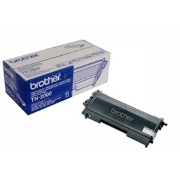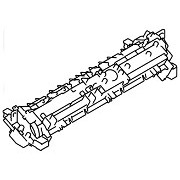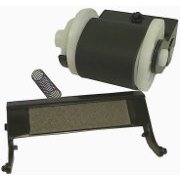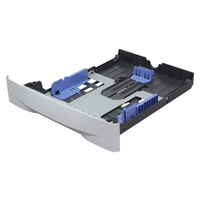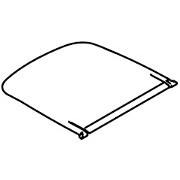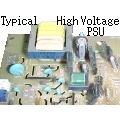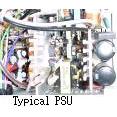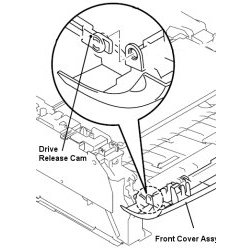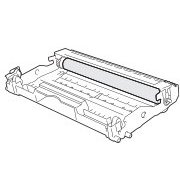Brother Original Toners
Fuser
Spares

Brother HL-2030
Brother HL-2030, HL-2035, HL-2040, HL-2045, HL-2070, HL-2075
These are A4 mono laser printers with true 1200 dot per inch print resolution, small form factor and around 20 page per minute throughput. The HL-2030, HL-2040 and HL-2070N were a new engine design first released in January 2005.
Brother use a naming scheme where the "20" is the page per minute throughput and the "30" is the low feature model whilst the "70N" is full featured and includes an Ethernet print server. The printers were unusually low cost - the HL-2040 was priced at just $137 in the US at launch. The range has since been expanded with the HL-2035, HL-2045 and HL-2075.
Brother favour a split toner and drum cartridge design which these printers use. The Toner is known as the TN350 in the US and the TN2000 in the UK and Europe and has a life of 2,500 pages at 5% page-cover. This toner has the low capacity typical of small printers. The toner matches a DR350 drum which Brother call the DR2000 in Europe. The drum unit has a life or 12,000 pages at 5% cover.
- HL-2030 - 17 page per minute, USB connection, 8MB RAM GDI language.
- HL-2040 additional parallel port (useful for older windows systems) 8MB RAM GDI language.
- HL-2070N - Ethernet giving Network print from any computer and remote control via a web server 16MB RAM, PCL6, Epson FX-850 and IBM Proprinter XL languages.language.
- HL-2037 was added in July 2008.
- HL-2035 added in September 2008.
The 2035 and 2037 are both GDI Printers with much the same specification as the 2030 but fractionally faster at 18ppm A4 / 19 ppm US-Letter.
Other printers using the same engine and so having common parts include:
- Fax-2820 and Fax-2920 are fax machines based on the same engine.
- MFC-7220 MFC-7225N MFC-7420 and MFC-7820 are fax-copiers based on the same engine.
- DCP-7020 is a digital copier based on the same engine.
These all take the TN350 / DR350 cartridge and drum pair.
- HL-2140, HL-2150N and HL-2170W are similar but somewhat faster at 23ppm.
These take the TN-330 1,500 page or TN-360 2,600 page cartridges and the DR-360 Drum.
Control:
These printers have a button and four LED-lights. The printers indicate toner, drum and toner errors with individual lights. Fuser errors are indicated by lighting all the lights, then when "Go" is pressed lighting the toner LED. There are several obscure messages detailed briefly below and more fully in the user's guide and service manual.
The printer has a single "Go" button. Typically this recovers from an error condition so having to press it alerts the user that something went wrong. "Go" can also:
Print any data that is left in the printer memory. If the green ready LED blinks for a long time, the printer doesn't seem to have ever received a command that would actually cause it to print. Pressing "Go" will force printing in this situation.
If there is an explicit error pressing "Go" may clear it and move the printer to a usable state.
Wake-up and print should happen automatically when the printer receives data; if it doesn't then "Go" should cause it.
Reprint of a page will happen if "Go" is held for 4 seconds until all the LEDs light up.
Cancel of a print job will happen if "Go" is held for 4 seconds, Ready and Paper flash.
Further messages are:
- Yellow Toner light blinking, Green Ready light on: Toner Low
- Yellow Toner light on, Ready light out: Toner out
- Yellow Drum light blinking, Green Ready light on: Drum life low
Service Calls are shown by all lights flashing. Press "Go" to get a secondary error message:
- Yellow Toner light on: Fuser Error
- Yellow Drum light on: Laser Error
- Yellow Toner and Red Paper light on: Main Motor Error
- Red Paper light on: Engine PCB Error
- Yellow Drum and Red Paper flashing - clean the corona wire.
The HL-2035 and HL-2037 have the corona wire cleaning message (others don't). This may also happen if the electrodes on the printer need to be cleaned (the metal contacts around the drum).
Before worrying about the cost of a service call make sure the front cover is closed.
Power off the printer, wait a few seconds, turn it on again and wait to see what happens. If it repeatedly goes to error then there is a problem.
The printer has service modes entered by powering on with "Go" held. Details are given in the service manual. But to print a test page:
- Turn the printer on whilst holding the "Go" button.
- All the LEDs will light, then go off.
- When the Toner Light comes on release the "Go" button
- Now press and release go again, the printer should produce a test page
Duty Cycle:
Brother don't tend to give a duty cycle in the way that HP and Lexmark do but the service manual gives the following indications
Machine Life: 50,000 pages/ 5 years
MTBF (Meantime between failure): Up to 4,000 hours
MTTR (Meantime to repair): Average 30 minutes
Monthly volume: 10,000 pages
Periodical replacement parts: Non
These printers are quite repairable and are likely to need new rollers and a fuser if they are to be kept going.
The low MTTR might reflect a view that it just isn't worth spending any time to repair anything worth less than $500 in the US market. Views in the UK and Europe differ.
Brother make spares available at quite reasonable prices and so these printers are fairly easy to keep going.
Print Speed:
Up to 20 pages per minute.
The service manual suggests the HL-2020 will work at
- Up to 16 pages/minute (A4)
- Up to 17 pages/minute (Letter-size paper)
The HL-2040 and HL-2070N are marginally faster
- Up to 20 pages/minute (A4)
- Up to 20 pages/minute (Letter-size paper)
First Print: Less than 10 seconds when the printer is in the ready state, using A4 or letter sized paper from the standard tray.
Warm up time: Maximum of 18 seconds at 23°C (73.4°F)
Print speed will vary considerably with media settings (it is slower with heavy media)
Print Resolution:
As so often happens with laser printers there is a difference between try engine resolution and user perceived resolutions based on the use of aliasing and dither patterns in the driver and the printer itself.
True resolutions are quoted as
- 300 dpi
- 600 dpi
These printers also have Brother HQ 1200 which Brother sometimes describes as "Up to 2,400x600dpi".
The resolutions selectable depend on the operating system and language support.
Paper Handling:
A4/ US letter paper path with a manual feed slot and a 250 sheet paper cassette.
Manual Feed Slot:
There is a single sheet manual feed slot taking media meeting the following specifiaction:
Width: 69.9 to 215.9 mm (2.75 to 8.5 in.)
Length: 116 to 406.4 mm (4.57 to 16 in.)
The printer driver offers the following media types:
Plain Paper, Recycled Paper, Bond Paper, Thick Paper, Thicker Paper, Transparencies, Envelopes
Tray 1:
An adjustable cassette sliding into the printer base. Paper sizes accepted are A4, US-Letter, US-Legal, B5(JIS), B5(ISO), Executive, A5, A6, B6(ISO)
Types: Plain paper, Bond paper, Recycled paper, and Transparencies*9
Weights: 60 to 105 g/m2 (16 to 28 lb)
Options:
None - the printers are not expandable.
Paper Quality:
Basis weight: 60 to 105 g/m (16 to 28 lb.)
Caliper: 0.08 to 0.12 mm (0.003 to 0.005 in.)
Moisture content: 4% to 6% by weight
Recommended papers
Plain paper: Xerox Premier 80 gsm, Xerox Business 80 gsm, Modo Paper DATACOPY 80 gsm
Recycled paper: Xerox Recycled Supreme N/A
Transparency: 3M CG3300 3M CG 3300
Label: Avery laser label L7163.
The printer can use recycled paper that meets the DIN 19309 specification.
Brother's user and service manuals give extensive infomation on paper quality and paper problems are indeed the likely source of problems with laser printers. Isuues are normally excessive damp.
Nevertheless these printers should work satisfactorily with any standard office paper.
Face Down:
100 sheet tray built into the top of the printer.
Face Up:
Not stated
Duplex:
The driver supports manual duplex printing. Paper quality has to be suitable, the paper must not curl excessively after printing the first side.
Processor:
The processor in a printer is primarily used to create the page raster image from the print language. A more powerful processor will be able to handle complicated data more quickly.
HL-2030 and HL-2040 Fujitsu SPARClite 96MHz
HL-2070N Fujitsu SPARClite 133MHz
Memory:
Memory is largely used to hold "rasterised" page images created by the print processor from the print language. The HL-2030 and HL-2040 are Windows GDI printers so the user's computer does most of this. The page image is communicated in Windows primitives and the printer doesn't need to do much. The HL-2070N has the common printer language PCL6.
HL-2030 and HL-2040 8MB
HL-2070N 16MB
There is no memory expansion option on these printers.
Interface:
The interface connects the computer(s) to the printer
- HL-2030 Full Speed USB 2.0
- HL-2040 Full Speed USB 2.0 and IEEE 1284 Parallel
- HL-2070 Full Speed USB 2.0, IEEE 1284 Parallel and Ethernet 10/100BASE-TX
Note that USB was not supported under Windows 95 or NT.40 however these operating systems are now rare.
Network:
Printers can use :
- HL-2030 - an extra NC-2200w IEEE 802.11b wireless print server.
- HL-2040 - an extra NC-2100P print server or NC-2200w wireless print server.
- HL-2070N - Built in 10/100Base_TX print server or NC-2200w IEEE 802.11b wireless print server.
Wired network protocols for the HL-2070N are:
TCP/IP - APR, RARP, BOOTP, DHCP, APIPA (Auto IP), NetBIOS Name Resolutions, WINS, DNS Resolver, LPR/LPD, Custom Raw Port/Port9100, SMTP Client, SMB Print, IPP, FTP Server, mDNS, TELNET, SNMP, HTTP
Management Tools:
- Web Based Management (HTTPD)
- BRAdmin Professional
- Web BRAdmin
Specifications for tthe NC-2200W option.
Network interface: IEEE 802.11b wireless
Communication Mode: Infrastructure / Ad-hoc 802.11
Security: SSID, WEP (64/128bit)
Printer Interface: USB 1.0
Support Protocol: TCP/IP
Management Features: SNMP / MIB support; TELNET remote console; BRAdmin Professional compatible; Flash memory for easy updating of firmware
Print Languages:
These printers all use the same engine but can use different drivers and print languages.
A print language determines how computers send print jobs from the user application through the print driver, through the interface to the printer.
Computers do not usually send every pixel direct to the printer because this would result in a huge transfer somewhere between 1 and 128 megabytes depending on the number of pixels and greyscale. There are many print languages; the least capable are GDI printers which largely rely on the computer to interpret the page and basically do send that big bitmap.
The HL-2030 and HL-2040 are essentially GDI printers.
PCL is generally agreed to be mid-range, the computer reduces the page to a common language understood by many printers.
The HL-2070N supports PCL with 49 scalable fonts, 12 bitmap fonts, 11 bar codes
The de-facto common language for printers used in the graphics trades is PostScript which can be supplied by its originators Adobe or emulated by drivers written by or for the printer manufacturer. These printers don't offer PostScript.Bar codes are: Code39, Interleaved 2 of 5, EAN-8, EAN-13, UPC-A, UPC-E, EAN-128, Codabar, FIM (US-PostNet), ISBN, Code128
System-Compatibility:
The HL-2030 and HL-2040 Have a GDI driver for Windows 9x/Me, 2000 and XP. There is also a Brother Laser Driver for Mac OS 9.1 to 9.2 and Mac OS X 10.2.4 or greater.
Brother produce a GDI Printer Driver for Linux. The HL-2070 can use a PCL driver for Windows 9x/Me 200 and XP/
Brother say for Windows 8 that The built-in drivers support the basic functions of your Brother machine.
.
Power:
There are two models matching the two common power supply voltages:
USA and Canada: AC 110 to 120 V, 50/60 Hz
Europe and Australia: AC 220 to 240 V, 50/60 Hz
Brother recommend that the power cord, including extensions, should not be longer than 5 metres and should not share the same circuits with other high power appliances. This is because the fuser in the printer will draw a high current intermittently even though overall the device does not draw much power. Sharing a circuit in these circumstances can cause mysterious behaviour such as machines crashing.
Power Consumption:
Power consumption will vary greatly as the fuser heater activates:
Printing Average 450 W at 25 C (77 F)
Standby Average 70 W at 25 C (77 F)
Sleep Average 5 W except the HL-2070N uses 7W
Environment:
These printers have an economy printing mode which saves 25% or 50% of the standard toner use by making printing somewhat lighter. The lighter print saves money for tasks like proof-reading.
Sleep mode reduces the power consumption to less than 8W.
Separate toner and rum units allow the user to replace only the components needed to keep the printer going.
Dimensions:
All models:
371 361 165.5 mm (14.6 14.2 6.5 in.)
Weight:
All models:
Approx.5.4 kg (12.0 lb) not including the drum unit and toner cartridge
Approx.6.5 kg (14.3 lb) including the drum unit and toner cartridge
Acoustic Noise:
Sound pressure
Printing Less than 51 dB (A)
Standby Less than 30 dB (A)
Sound power
Printing 6.2 Bell (A)
Standby 4.3 Bell (A)
Brother's user manual makes the interesting note: "Office equipment with LW Ad 6.3 Bell (A) is not suitable for operation in rooms where predominantly intellectual work is done. Due to their noise emissions, these devices should be set up in separate rooms."
Consumables:
Separate toner cartridge and drum unit. The idea of using separate toner and drum is to decrease the printer ownership costs. To fit the small profile of the printer both have limited size and lives.
When handling either toner or drum either do so on a surface that will not be stained by any lose toner or cover the surface with material such as disposable tissue paper.
Brother suggest cleaning the scanner window on the inner top face of the printer when replacing a toner or the drum. They also recommend cleaning the contact terminals with a soft dry cloth, the power should be off to do this. Beware of static charges when doing this, do not touch the terminals if your body or the cloth might be charged with static.
If hands, clothes or furnishings come into contact with toner brush it off or use cold water.
The printer indicates that toner is nearly finished by flashing a light on for two seconds and off for 3 seconds. When the light is continaully on the printer has run out of toner. It may be worth gently shaking the toner and drum to redistribute any remaining toner.
TN-350 TN-2000 in the EU. Toner life 2,500 pages A4/Letter pages @5% coverage
New printers come with a starter cartridge rated for 1,500 pages. The starter cartridge lacks the gear mechanism to allow a refill to work.
The service manual gives the shelf-life of toner as 2 years (or 6 months after opening)
To replace a toner take the drum assembly out of the printer and release the cartridge using the blue lock lever. Pull the protective cover off the new toner-developer unit and put it in place. The blue lock lever should spring up and engage; if it does not the cartridge is not seated properly and that must be done before the drum is put back in the printer.
Before putting the drum into the printer clean the corona wire on the drum assembly by sliding the blue cleaner tab back and forth several times then returning it to it's home position.
Drum
When the Drm LED lights the drum is near the end of it's life and will need replacing before there is a deterioration in print quality.
DR-350 in US, DR-2000 in EU. Drum Life 12,000 A4 / Letter pages (1 page /job)
The service manual gives the shelf-life of the drum as 2 years (or 6 months after opening - but it is always unwise to open a drum until it is needed as they decay on exposure to light)
To replace the drum. With the power on open the front cover, making sure the drum light is blinking. Press and hold "Go" for about 4 seconds until all the lights come on, once all four LEDs are on release the "Go" button.
Remove ther from the printer, release the toner cartridge and set it aside. Unwrap a new drum and latch the toner onto it making sure it loacks in place. Put the drum and toner assembly back in the printer. See instructions with the drum to make sure the drum counter is reset and the Drum LED is now off.
Fuser:
Laser printers produce an image in toner powder, this is fixed to the page by a combination of heat and pressure in the fuser. The fuser hot roller is coated in non-stick material to prevent it sticking to the image but over time the material loses its qualities and the fuser or the roller needs to be replaced.
LM6721001 Fuser Unit, 115V I-10/5 HL-2030, HL-2040 (SP)
LM6723001 Fuser Unit, 230 V I-105 (SP)(White thermistor connector Some UK distys have this)
See the note below:
Most technicians working on printers replace the whole fuser theses days. Stripping and rebuilding the fuser can be time consuming and it sometimes turns out that bushings, bearings or gears have aged and they break during the work. Brother do give details on fuser strip-down in the service manual so people may want to buy parts for the fuser.
LM4009001 Heat Roller
LM4010001 Heat Roller Gear
LM4012001 Halogen Heater, 115V
LM4022001 Halogen Heater, 230V
LM4013001 Pressure Roller
LM6735001 Heat Roller Bush L
LM6736001 Heat Roller Bush R
LM9013001 Thermistor Adaptor
LJ9740001 Toner Sensor PCB Assy ALL
Note on Thermistor connector
Note that this seems to be one of those fusers where the connectors can vary - there are varaints with a grey and a white connector. The service manual for the printer says nothing about this excepting that it lists three different fusers of which two are found in UK distribution.
There are actually several different fusers listed in the service manual which UK suppliers sometimes seem to have so for completeness here are the numbers.
LM6721001 Fuser Unit, 115V I-10/5 (SP)
LM6723001 Fuser Unit, 230 V I-105 (SP)(White thermistor. Some UK distys have this)
LM6722001 Fuser Unit, 115V S-10/5 (SP)
LM6724001 Fuser Unit, 230V S-10/5 (SP)(Grey Thermistor Connector. Some UK distys have this)
LM6725001 Fuser Unit, 230V IND S-10/5 (SP)
Maintenance Kit:
Brother don't seem to supply maintenance kits however they do provide a Paper Feeding Kit. LM6291001 Paper Feeding Kit
Spares:
This is a short list of spares based on what seems to be in stock and in demand for the printer. The complete list is around 200 lines long.
LM6291001 Paper Feeding Kit (was LM4581001)
LM4300001 Pick-up Roller and Holder Assy
LM4143001 Separation Pad Holder Assembly for Paper Tray
LJ7432001 Cleaner Pinch Roller Assy L (Frame Unit)
LM4105001 Eject / Exit Roller Assy
LM6289001 Exit Pinch Rollers and Springs
LM6598001 Exit Pinch Rollers and Springs
LM6309001 Eject Actuator Spring
LM6320001 Paper Eject Actuator
LM4225001 Develop Drive Gear (Frame Unit)
LM4625001 Cover Sponge (round the cover lower edge)
LM4972001 Rear Chute Cover
LM6229001 Rear Cover Dark Grey
LM6331001 Paper Tray Assembly Europpe, Light Gray (1581)
LM6331002 Paper Tray Assy Dark Gray
LM6333002 Paper Tray Assembly Europe, Dark Gray (1736)
LM4578001 Laser Unit
LM4265001 Fan Motor 60 Unit
LM4570001 Filter Assembly
LM4341001 Main Motor Assembly
LJ9712001 Main PCB Assembly 2030 FLASH
LJ9797001 Main PCB Assembly 2040 FLASH
LJ9764001 Main PCB Assembly 2070N FLASH
Whats-In-The-Box:
Printer, drum and a starter catridge.
Service:
We offer repair in North East England. We are researching other options.
Options:
We offer repair in North East England. We are researching other options.
Copyright G & J Huskinson & MindMachine Associates Ltd 2013, 2015. Some pictures derived from Brother User and Service guides. These technical pages do not constitute an offer for sale; just our knowledge at the time of writing. See the catalog. Sales pages on this Web site use cookies to store user information. We also use Google Analytics to track site usage patterns.

